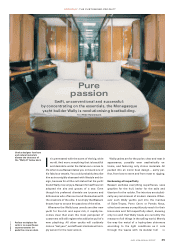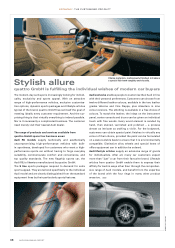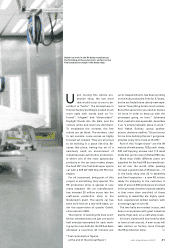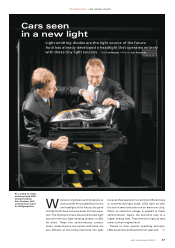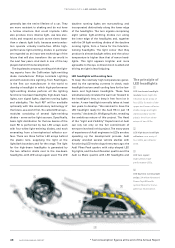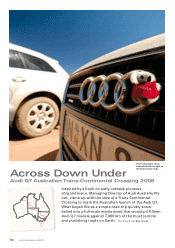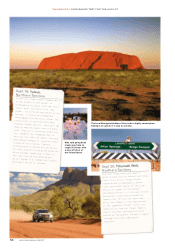Audi 2006 Annual Report Download - page 46
Download and view the complete annual report
Please find page 46 of the 2006 Audi annual report below. You can navigate through the pages in the report by either clicking on the pages listed below, or by using the keyword search tool below to find specific information within the annual report.
“In launching the pilot
project ‘Audi Silver Line’,
Audi is responding to
demographic change
by focusing on and
specifically seeking to
utilise the strengths
of “older” employees
for R8 production.”
Top right, opposite: despite the use of robots,
the level of automation in the R8 manu-
facturing process lies at just 25 percent.
Bottom right, opposite: only after it has
received a thorough final check in the light
tunnel does a car leave the assembly line.
Futuristic look with the tailgate opened.
TECHNOLOGY: AUDI R8 PRODUCTION
PHOTOS: AUDI
44 AUDI 2006 ANNUAL REPORT
the strengths of “older” employees for
R8 production. Dr. Werner Widuckel,
AUDI AG Board of Management Mem-
ber for Human Resources, explains:
“This new model seeks to make the
best possible use of valuable voca-
tional experience.” But he is at pains to
add: “The work involved is by no
means an ‘easy option’. If anything, the
low number of production sequences
means a greater range of work is in-
volved in each cycle. The high complex-
ity of a vehicle such as the Audi R8*
means very experienced workers are
needed. At the same time, the longer
working cycles reduce the physical
burden on the workers.”
Assembly
The R8 assembly line occupies an area
of 5,370 square metres. It comprises 14
assembly cycles and eight preassembly
areas located in the immediate vicinity
of the fitting cycles. The hall also hous-
es commissioning, the track test bench
and the roller dynamometer. The en-
gine, suspension, radiator, windows,
control units, rear lid, cockpit and doors
are preassembled.
90 percent of the materials in assem-
bly are brought to the assembly stages
in component baskets. The component
baskets are prepared by assembly
workers operating as a team.
The parts required for fitting to pre-
cisely one vehicle are collected in a
component basket in the “supermarket
zone” or directly at the assembly line.
The worker on the assembly line takes
the materials for the vehicle on which
he is working from the component bas-
ket. In other words, he does not need to
leave the “worker zone” to collect each
part, and the materials needed for each
assembly step are in the immediate
vicinity of the car and ergonomically
within the worker’s reach.
The component baskets are fitted with
inlays to prevent painted parts in par-
ticular from being damaged. The inlays
mean that every component has a de-
fined location and the optimum order of
fitting is specified automatically. This
order is visualised by the numbering of
the components displayed on the bas-
ket. This serves as an exact overview for
the worker as to which parts have al-
ready been installed. In other words,
the assembly process for each cycle is
complete when the basket is empty.
This reduces personnel traffic and ren-
ders the process more reliable.
The materials are delivered to the as-
sembly line and the supermarket zones
by floor conveyor vehicles. These vehi-
cles transport the materials to the point
at which they are required on trailers
that are joined together like rail cars.
No fork-lift trucks are in use in the R8
assembly.
The supermarket zones have the same
structure as the individual component
baskets, so each of the zones in which
the baskets are filled contains only the
materials for one particular basket.
Every standard or small part and every
tool has a defined place on the assem-
bly trolley. All tools are in addition
colour-coded and therefore assigned to
a specific cycle. This ensures that the
“wrong” tool is not used.
Road test
Once the R8 has passed check point 7
(ZP7), where the car’s test chart is
scanned and the underbody and engine
compartment are checked, the road-
ready sports car now goes for a “road
test”. This involves driving the cars
both on the internal test track and in
ordinary traffic. The duration of the road
test is about two hours on both tests
combined. At the factory, the vehicles
are driven over the “shake stretch” and
through a banked curve, as well as put
through a brake test. The test drives
include inspections of the engine com-
partment and checks of various func-
tions (lights, air conditioning, naviga-
tion system, radio, mirrors, etc.).
Final approval
After the road test, the vehicle arrives at
the finishing hall for its final approval
at check point 8 (ZP8), in other words
for the final vehicle inspections. The fin-
ishing is done together with quattro
GmbH’s RS models. Before being driven
into the hall, every vehicle is washed
and prepared in a drip zone for the
“sprinkle test” to check for watertight-
ness. The R8 is now sprayed with
around 1,200 litres of water for the dura-
tion of six minutes, dried and checked
for water penetration.
There then follow the interior check,
the paint/surface finish check in the
light tunnel, various functional checks
and electrical checks (control units).
Once the vehicle has been cleaned and
the checks completed, the R8 receives
its official final approval. Before leaving
the finishing hall, the headlights are
adjusted and the transit packaging is
fitted. The sports cars are then loaded
for shipping to the customer.
Board Member for Production Dreves
concludes: “It takes incredible expertise
and just as much passion and emotion
to build a car of the calibre of the
Audi R8. And our employees are not
lacking in any of these qualities. Every-
one is immensely enthusiastic about
this car. As our customers will be, of that
there can be no doubt.”
* fuel consumption figures at the end of the Annual Report



